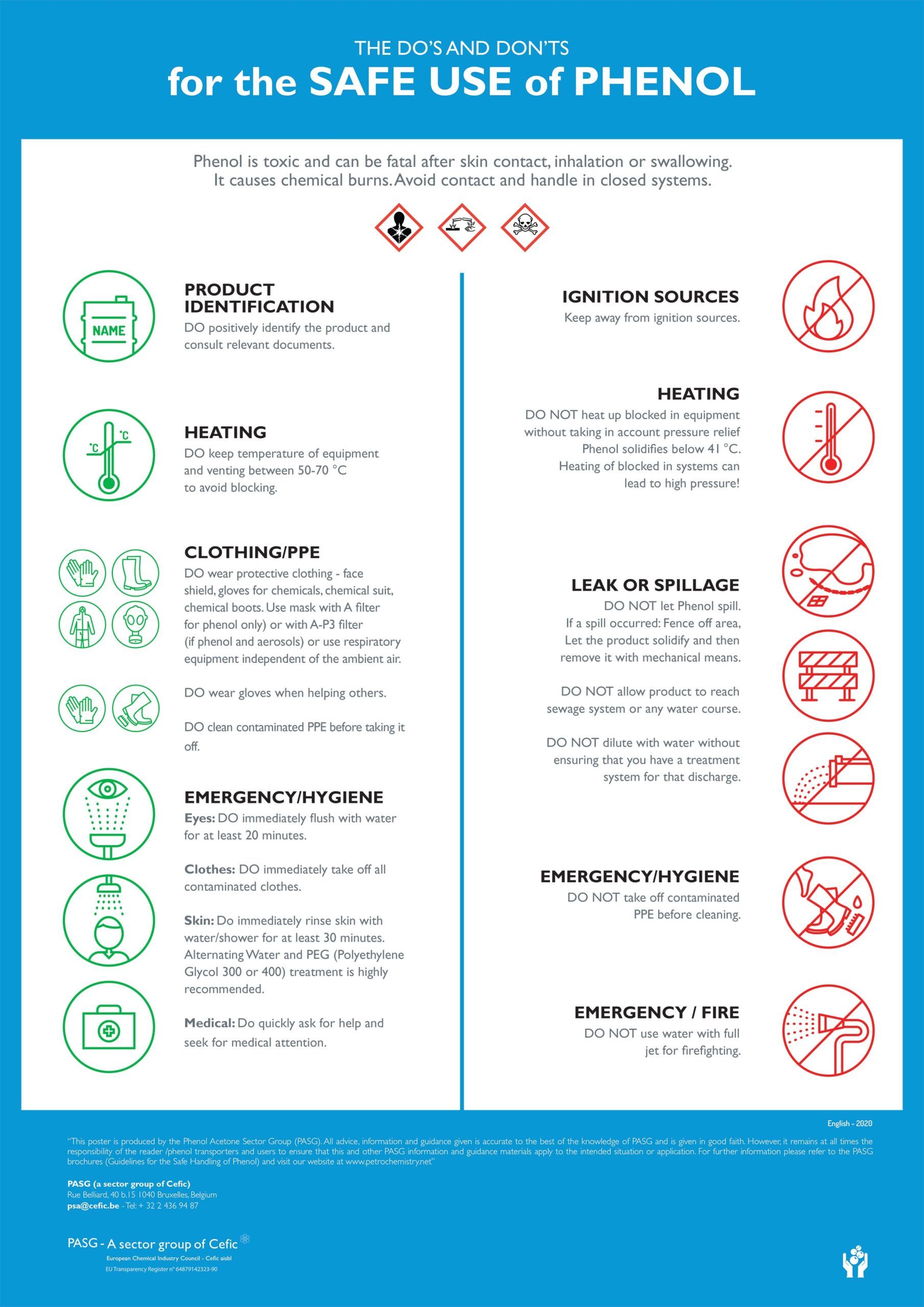Phenol, Acetone & Cumene
Uses and Properties
The Phenol & Acetone Sector Group (PASG) is a trade association bringing together the European manufacturers of phenol, acetone as well as their raw materials.
Phenol is mainly used as an intermediate in organic synthesis. In this, phenol essentially serves as a raw material for the production of bisphenol A, phenolic resins, alkylphenols and caprolactam. It is also used for salicylic acid, nitrophenols, diphenyl ethers, halogenated phenols and other chemicals.
Phenolic resins, or phenol-formaldehyde polymers, were the first completely synthetic polymers to be commercialised. Although moulded products no longer represent their most important application, through their use as adhesives they still represent almost half of the total production of thermosetting polymers.
Bisphenol A is a building block for making polycarbonate resins, which are used for structural parts, impact resistant glazing, street-light bulbs, household appliance parts, components of electrical/electronic devices, automotive applications, reusable bottles, and food and drink containers. It is also a building block used to make epoxy resins for coatings, electrical laminants, composites and adhesives.
Alkylphenol is mainly used as a stabiliser for rubbers and plastics, as a surfactant, as an industrial detergent, and in the mining and textile industries.
Caprolactam is a raw material for the manufacture of some nylons.
Issues and Regulations
REACH Implementation
A “Phenol & Acetone” REACH Consortium was formed through which manufacturers have joined efforts to prepare by 30 November 2010 consistent registration dossiers covering phenol and its derivative substances including phenol, acetone, cumene, alphamethyl styrene, acetophenone, di-isopropyl benzene, CHP and “high boiler”.
Project Management: ReachCentrum.
Regulation
The Sector Group is pro-actively managing regulatory and environmental responsibilities on the industry:
- Health: SCOEL / Occupational Exposure Limits, Classification issues
- Environment: CO2 emissions (benchmarks), Industrial Emissions Directive (BREF)
Specific Issues
- Exchange non-confidential safety information about the production, distribution and handling of phenol.
- Promoting the standing of the phenol and acetone industry in a socially responsible manner.
- Informing consumers and those involved in the handling of the products on its properties and functionality.
- Encouraging the safe and proper use of phenol by developing and publishing appropriate technical information.
- Maintaining a high level of technical understanding by identifying and managing research into health and environmental effects and assessing risks in use.
- Organising and funding toxicology projects, in collaboration with the US Phenol Panel where appropriate.
- Presenting a positive image of phenol and acetone to the industry, authorities and the public.
- Developing a common position on major issues of the industry for presentation to regulators, opinion leaders and other concerned bodies.
- Developing product stewardship programs following the Responsible Care principles
Additional Information
The Do’s and Don’ts poster below was produced jointly by the PASG Sector group member companies and Cefic. It aims at giving a quick overview of safety good practices when handling phenol during transport.
Guidelines for the Safe Handling of Phenol (2021)
Although phenol is a hazardous material in terms of toxicity and corrosivity, it can be distributed and handled safely provided that appropriate precautions are observed. The transport of phenol in bulk is subject to strict regulations within most countries in Europe. In addition, the international movement of phenol by road, rail or sea is subject to international agreements laying down specific requirements concerning transport, which must be observed by all parties involved.
These guidelines have been prepared by the Cefic (European Chemical Industry Council) Phenol and Acetone Sector Group to establish appropriately high standards of safety for the safe handling of phenol. These guidelines take into account the transport of phenol in bulk in road tankers, rail tank wagons and tank containers. They cover all aspects of the transport activity from loading to delivery point. Reference to existing regulatory controls is only made where this is considered necessary for the purpose of clarification.
The Cefic Phenol and Acetone Sector Group recommends that these guidelines be adopted by all parties who are involved in the distribution of phenol, and will arrange a regular review of these guidelines. In order to facilitate effective supervision of safety in transport to destination, it is recommended that phenol producers should arrange transport themselves.
Cefic transport and logistics best practice guidelines
Eco-profile & Environmental Product Declaration for Phenol Acetone (2016)
Chairperson
Coral Verge, CEPSA Quimica
Contact
Vollmann Marcelo
Sector Group Manager
mvo (@) cefic.be

